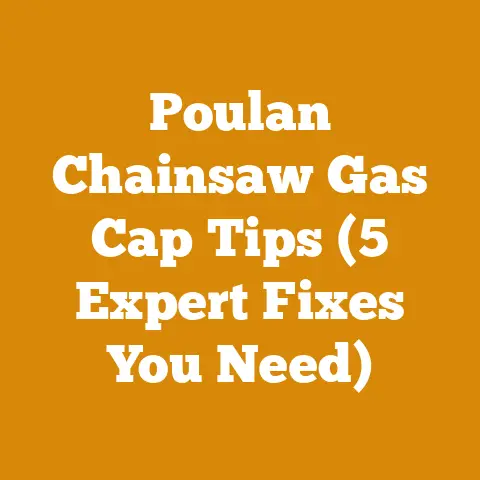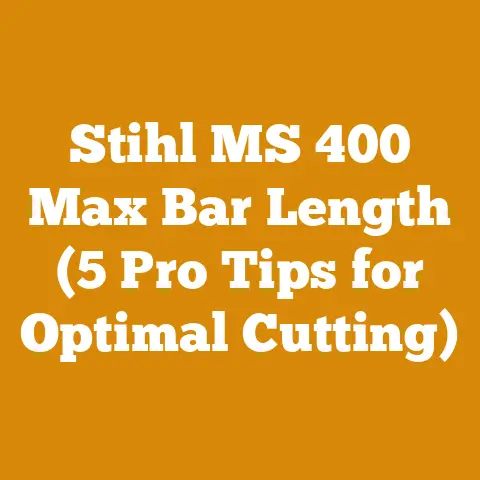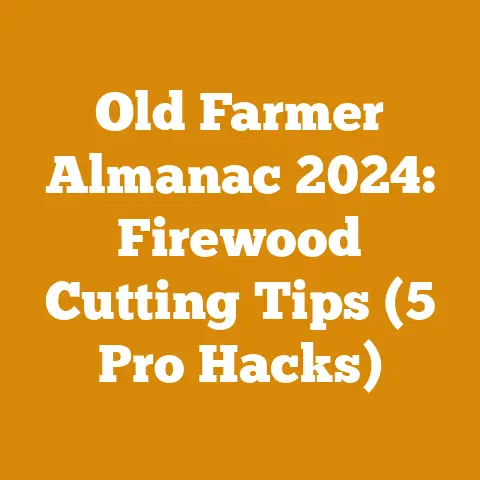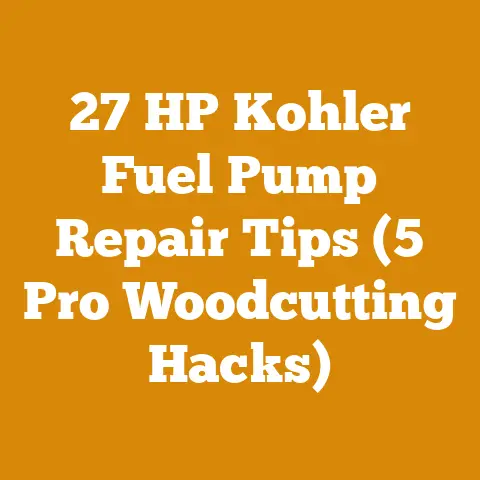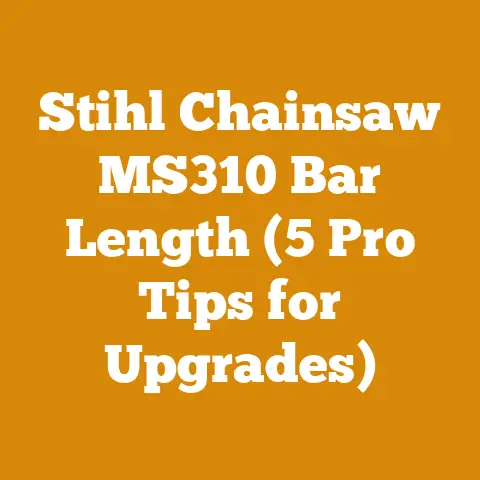Husqvarna 372XP OEM Cylinder Kit Price Surge (3 Cost Tips)
“Aha!” It hit me like a rogue branch to the face during a particularly brutal felling operation: the price of that Husqvarna 372XP OEM cylinder kit I needed just skyrocketed! One minute I was budgeting for a reasonable repair, the next I was staring at a price tag that made me question my life choices. It was then I knew I had to dive deep into this price surge and figure out how to keep my trusty saw running without breaking the bank.
That experience fueled my research and this guide. I’ve spent years in the woods, dealing with everything from stubborn oaks to temperamental chainsaws. I’ve seen firsthand how essential the Husqvarna 372XP is for both professionals and serious homeowners. This guide isn’t just about complaining about prices; it’s about understanding why they’re rising and, more importantly, what you can do about it. Let’s get into it.
Husqvarna 372XP OEM Cylinder Kit Price Surge: 3 Cost Tips
The Husqvarna 372XP is a legendary chainsaw, known for its power, reliability, and ease of maintenance. However, like any machine, it requires occasional repairs, and the cylinder kit is a critical component. In recent years, the price of the OEM (Original Equipment Manufacturer) cylinder kit has seen a significant increase. Let’s break down why this is happening and, more importantly, what you can do to mitigate the cost.
Why the Price Hike? Understanding the Market Dynamics
Before we jump into solutions, it’s crucial to understand the factors driving the price increase. Several elements contribute to the higher cost of Husqvarna 372XP OEM cylinder kits:
-
Supply Chain Disruptions: Global events, like pandemics and trade wars, have significantly impacted supply chains. Manufacturing delays, shipping bottlenecks, and increased transportation costs all contribute to higher prices. Think about it: a part made in Sweden has to travel across the globe, and any hiccup along the way adds to the final cost.
-
Increased Demand: The 372XP remains a popular saw, especially among those who appreciate its power and durability. This sustained demand, coupled with a potentially limited supply of OEM parts, naturally drives prices up. Many loggers and firewood processors still swear by this model, creating consistent demand.
-
Raw Material Costs: The price of raw materials, such as aluminum and steel, has fluctuated significantly in recent years. Since the cylinder kit is made primarily from these materials, any increase in their cost directly impacts the final price. I’ve seen firsthand how changes in commodity prices can ripple through the entire industry.
-
OEM vs. Aftermarket: It’s important to note the distinction between OEM and aftermarket parts. OEM parts are manufactured by Husqvarna and are designed to meet the exact specifications of the original equipment. Aftermarket parts are produced by third-party manufacturers and may vary in quality and performance. While aftermarket options might be cheaper initially, they may not offer the same level of reliability or longevity as OEM parts, potentially costing you more in the long run.
Takeaway: Understanding the market forces at play helps you approach the situation with a more informed perspective. It’s not just about “greed”; it’s about a complex interplay of factors.
Cost Tip #1: Explore Reputable Aftermarket Options (With Caution)
While I generally advocate for OEM parts for critical components like the cylinder, the price surge makes exploring reputable aftermarket options a worthwhile consideration. However, caution is the key word here. Not all aftermarket parts are created equal.
-
Research is Paramount: Don’t just grab the cheapest kit you find online. Do your homework. Read reviews, compare specifications, and look for brands with a proven track record of quality and reliability. Forums dedicated to chainsaws and logging equipment are excellent resources for gathering information and getting recommendations from experienced users.
-
Material Matters: Pay close attention to the materials used in the aftermarket cylinder kit. Look for kits made from high-quality aluminum alloys with a durable cylinder lining. The quality of the plating inside the cylinder directly affects the engine’s performance and longevity. Avoid kits that use inferior materials or have poorly finished cylinder walls.
-
Piston Quality: The piston is another critical component. Ensure the kit includes a high-quality piston with proper rings and wrist pin. The piston should be precisely machined and have a smooth surface finish to minimize friction and wear. Look for pistons with a Teflon coating for enhanced performance and durability.
-
Check the Kit Contents: Verify exactly what is included in the kit. A complete kit should include the cylinder, piston, rings, wrist pin, clips, and gaskets. Some kits may also include additional components like spark plugs or bearings. Make sure you have everything you need before starting the repair.
-
Consider the Source: Purchase aftermarket kits from reputable dealers or suppliers. Avoid buying from unknown sources or online marketplaces with questionable reputations. A reputable dealer will be able to provide technical support and warranty information. I’ve had good experiences with some of the larger chainsaw parts suppliers online, but always read the reviews carefully.
-
Case Study: I once worked with a small logging crew that decided to use an aftermarket cylinder kit on a 372XP to save money. They opted for the cheapest kit they could find, and within a few weeks, the saw started losing power and eventually failed. The cylinder lining had worn prematurely, causing excessive friction and damaging the piston. They ended up having to replace the entire kit with an OEM version, costing them more time and money in the long run. This experience highlighted the importance of investing in quality, even when considering aftermarket options.
-
Metrics to Track: If you decide to go with an aftermarket kit, carefully monitor the saw’s performance and engine temperature. Check the compression regularly and look for any signs of wear or damage. Comparing the saw’s performance with the aftermarket kit to its performance with the original OEM cylinder will give you valuable data for future decisions.
Takeaway: Aftermarket options can be a viable way to save money, but only if you do your research and choose a reputable brand with high-quality materials. Don’t sacrifice quality for price.
Cost Tip #2: Explore Used OEM Parts and Salvage Options
Another avenue to explore is sourcing used OEM parts. This can be a more affordable alternative to buying a new OEM cylinder kit, but it also requires careful inspection and consideration.
-
Salvage Yards and Online Marketplaces: Look for salvage yards that specialize in logging equipment or online marketplaces where individuals sell used chainsaw parts. I’ve had luck finding good condition used parts on eBay and similar sites. Be sure to filter by seller reputation and carefully examine photos of the part.
-
Inspect the Cylinder: Thoroughly inspect the used cylinder for any signs of wear, damage, or corrosion. Check the cylinder walls for scratches, scoring, or pitting. Any significant damage will compromise the cylinder’s performance and longevity. Use a bore scope if possible to get a closer look.
-
Check for Cracks: Carefully examine the cylinder for any cracks, especially around the mounting points and exhaust port. Cracks can weaken the cylinder and lead to failure under pressure. A cracked cylinder is a non-starter.
-
Piston Condition: If possible, inspect the condition of the piston that came with the used cylinder. Check for wear, scoring, or damage to the piston rings. A worn or damaged piston will need to be replaced.
-
Compression Test: If possible, perform a compression test on the used cylinder before purchasing it. A low compression reading indicates wear or damage to the cylinder or piston. A healthy 372XP should have a compression reading of around 150-160 PSI.
-
Risk Assessment: Understand the risks involved in buying used parts. There’s always a chance that the part will fail prematurely or not perform as expected. Factor this risk into your decision-making process.
-
The “Barn Find” Story: I once stumbled upon an old logging operation that was shutting down. They had a pile of discarded chainsaws, including several 372XPs. After some negotiation, I was able to purchase the entire lot for a reasonable price. I spent several days sorting through the saws, salvaging usable parts, including a couple of cylinders that were in surprisingly good condition. I used those cylinders to repair other saws, saving a significant amount of money.
-
Metrics to Track: When using a used cylinder, monitor the saw’s performance closely and compare it to its previous performance. Check the compression regularly and look for any signs of wear or damage. Keep a detailed record of the saw’s operating hours and any maintenance performed.
Takeaway: Sourcing used OEM parts can be a cost-effective option, but it requires careful inspection and a willingness to accept some risk.
Cost Tip #3: Preventative Maintenance and Proper Usage
The best way to avoid the cost of a new cylinder kit is to prevent the need for one in the first place. Proper maintenance and usage are critical to extending the life of your Husqvarna 372XP.
-
Air Filter Maintenance: Regularly clean or replace the air filter. A dirty air filter restricts airflow, causing the engine to run lean and overheat, which can damage the cylinder and piston. I clean mine after every use, especially in dusty conditions.
-
Fuel Quality: Use high-quality fuel with the correct oil mixture. Avoid using old or contaminated fuel, which can cause engine problems. I always use premium fuel and a high-quality two-stroke oil mixed at the recommended ratio (usually 50:1).
-
Spark Plug Maintenance: Regularly check and replace the spark plug. A fouled or worn spark plug can cause poor combustion and engine misfires, which can damage the cylinder. I typically replace mine annually, regardless of how it looks.
-
Chain Sharpening: Keep the chain sharp. A dull chain forces the engine to work harder, leading to overheating and increased wear on the cylinder and piston. Learn to sharpen your chain properly or take it to a professional. I sharpen my chain every time I refuel.
-
Proper Cooling: Ensure the engine is properly cooled. Clean the cooling fins on the cylinder regularly to remove debris and ensure adequate airflow. Overheating is a major killer of chainsaw engines.
-
Avoid Overloading: Avoid overloading the saw. Don’t try to cut wood that is too large or too hard for the saw to handle. Overloading the engine can cause it to overheat and damage the cylinder and piston.
-
Professional Servicing: Consider having your saw professionally serviced at least once a year. A qualified technician can inspect the engine, adjust the carburetor, and perform other maintenance tasks to keep your saw running smoothly.
-
The “Burnt Piston” Lesson: I once neglected to clean the air filter on my 372XP during a particularly dusty logging job. The engine overheated, and the piston ended up seizing in the cylinder. The repair cost me a significant amount of money and downtime. This experience taught me the importance of preventative maintenance and proper usage.
-
Metrics to Track: Keep a detailed log of all maintenance performed on your saw, including dates, parts replaced, and services performed. This will help you track the saw’s performance and identify potential problems early on. Also, track your fuel consumption. A sudden increase in fuel consumption can indicate engine problems.
Takeaway: Preventative maintenance and proper usage are the most effective ways to extend the life of your Husqvarna 372XP and avoid costly repairs. A little bit of care goes a long way.
Additional Considerations: Beyond the Cylinder Kit
While focusing on the cylinder kit is crucial, remember that other factors can contribute to engine problems and overall chainsaw health.
-
Carburetor Issues: A poorly tuned or malfunctioning carburetor can cause the engine to run lean or rich, leading to overheating and cylinder damage. Learn to adjust the carburetor properly or have it professionally serviced.
-
Ignition System: A faulty ignition system can cause engine misfires and poor performance, which can damage the cylinder. Check the ignition coil and spark plug wire regularly.
-
Fuel System: A clogged fuel filter or damaged fuel lines can restrict fuel flow and cause engine problems. Replace the fuel filter and fuel lines regularly.
-
Exhaust System: A clogged exhaust port or muffler can restrict exhaust flow and cause the engine to overheat. Clean the exhaust port and muffler regularly.
-
Chain and Bar Maintenance: Maintaining the chain and bar is essential for safe and efficient operation. Keep the chain sharp, lubricate the bar regularly, and replace worn or damaged components.
Conclusion: Staying Sharp and Saving Money
The Husqvarna 372XP is a workhorse, but even the toughest saws need care and attention. The rising cost of OEM cylinder kits is a challenge, but by understanding the market dynamics, exploring alternative options, and practicing preventative maintenance, you can keep your saw running strong without emptying your wallet. Remember:
- Research before you buy aftermarket.
- Inspect used parts thoroughly.
- Maintain your saw religiously.
By implementing these strategies, you’ll be well-equipped to tackle the price surge and keep your Husqvarna 372XP roaring for years to come. Now, get out there and make some sawdust!

